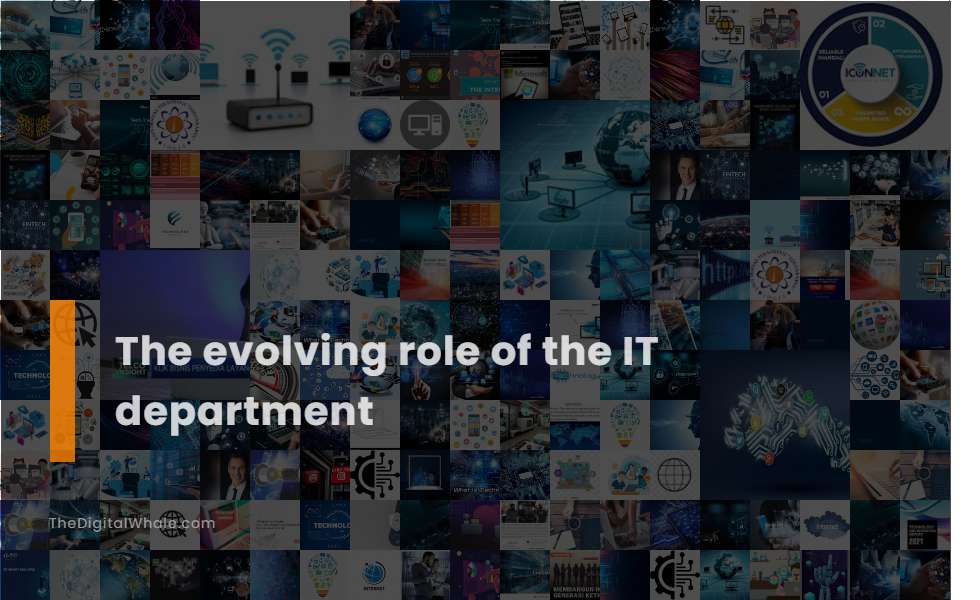The Evolving Role of the It Department
What are some of the benefits of working in the IT department of a company? What is the traditional caricature of the IT department? Let's find out more about The Evolving Role of the It Department.

Managing staff and adding value to the organization
The evolving role of the IT department, particularly under the leadership of a CIO, involves managing staff to align technology initiatives with business objectives, enhancing operational efficiency, and adding value by leveraging technology to create competitive advantages, increase revenue, and drive digital transformation. This role requires strong relationships with other business leaders, continuous improvement, and the exploration of new technologies to address business challenges and opportunities. For more insights on this topic, visit the Evolution Of The CIO blog.
Enhancing security and business agility
The evolving role of the IT department, particularly for Chief Information Security Officers (CISOs) and Chief Information Officers (CIOs), involves a shift from isolated silos to a collaborative approach, focusing on balancing innovation and security. This includes building cyber resilience, enabling business agility through supportive security solutions, and leveraging data-driven decision-making to ensure compliance and mitigate risks.
Driving change at an organizational level
The IT department, particularly through the role of the CIO, is increasingly pivotal in driving organizational change by fostering a culture of innovation. By introducing and managing new technologies, the CIO aligns these efforts with business strategy to enhance operational efficiency, customer experience, and competitive edge. Learn more about the impact of innovation management by visiting the CIO Council South Florida website.
Integrating IT across various departments (operations, finance, marketing, HR)
The evolving role of the IT department, particularly through the lens of the CIO, involves integrating IT across various departments such as operations, finance, marketing, and HR to align technology initiatives with overarching business goals, enhance operational efficiency, and create competitive advantages by leveraging technology to add value and increase revenue. In this context, Enterprise Resource Planning (ERP) systems play a crucial role by aggregating and distributing information, enabling cross-functional collaboration, and providing a single-system solution that integrates processes such as finance, human resources, logistics, and customer relationship management. This integration not only streamlines operations but also supports the organization's strategic objectives by facilitating data-driven decision-making across various functions.
Ensuring technology alignment with business goals
The evolving role of the IT department involves ensuring technology alignment with business goals by synchronizing IT strategies with overall business objectives. It is crucial to treat IT as an integral part of the business strategy to drive efficiency, innovation, and competitive advantage. For more insights on this, explore the importance of Business and IT Alignment and how it plays a pivotal role in modern enterprises. By creating a synergy between technology and business processes, companies are better positioned to meet market demands effectively.
Related:
How can you improve customer relationship management using data? What is the use of data mining for better customer relationship management? Let's find out more about Using Data Mining To Improve Customer Relations.
Managing digital transformation and cloud services
The IT department plays an essential role in the realm of digital transformation by adopting and managing new technologies to enhance business efficiency and productivity. Key responsibilities include implementing security measures and governance protocols, supporting cloud migrations, and orchestrating robust data management strategies. The role of a Cloud Service Manager, for example, is crucial in managing cloud contracts, enforcing service level agreements, and optimizing costs, ensuring lifecycle management aligns with overall business objectives. With digital transformation defined by technology selection and management, adopting Agile, FinOps, and hyperautomation methods drives innovation while reducing costs and accelerating time to market. A cornerstone in the IT service management (ITSM) cloud services landscape, the department ensures seamless service level management, asset and license governance, and effective problem-solving collaboration with cloud providers. For more comprehensive insights into this pivotal role, one might consider reviewing the detailed exploration available on Vast IT Services.
Fostering innovation and business growth
The IT department plays a crucial role in fostering innovation and business growth by leveraging technologies such as data analytics, AI, workflow automation, and IoT to gain deeper insights into customer behavior and market trends. This approach significantly enhances operational efficiency, differentiates offerings, and opens new revenue streams. For a deeper understanding of these strategies and their impact, you can explore the insights shared on Tech Azur.
Maintaining security integrity in BYOD and mobile device environments
The IT department plays a crucial role in maintaining security integrity in BYOD environments by implementing Mobile Device Management (MDM) solutions, enforcing robust encryption practices, using Identity and Access Management (IAM) solutions, and monitoring device compliance in real-time. These strategies are vital to protect against data leakage, malicious apps, and other security risks. For more insights on effective security measures, visit the Rippling Blog, where best practices for safeguarding digital environments are discussed in detail.
Acting as strategic business partners and change agents
The evolving role of the IT department involves acting as strategic business partners by aligning technology solutions with organizational goals, expanding IT professional skillsets, and leading cultural change. They serve as change agents who facilitate and manage IT transformations, oversee the change process, and ensure smooth implementation. This approach drives organizational efficiency and competitiveness, positioning the department as critical facilitators in the business landscape. To understand how IT departments can elevate their role further, visit CXO Tech Magazine for insights into leveraging IT as a strategic partner.
Overseeing the adoption of emerging technologies for competitive advantage
The evolving role of the IT department involves strategically overseeing the adoption of emerging technologies such as AI, ML, IoT, and blockchain to drive business goals, enhance operational efficiency, and gain a competitive advantage by aligning technology initiatives with broader business objectives and ensuring real business value.
Related:
What new trends are you looking forward to in the technology world in the next year? What is the "new normal" of technology? Let's find out more about The Usage of Technology In the Future.
